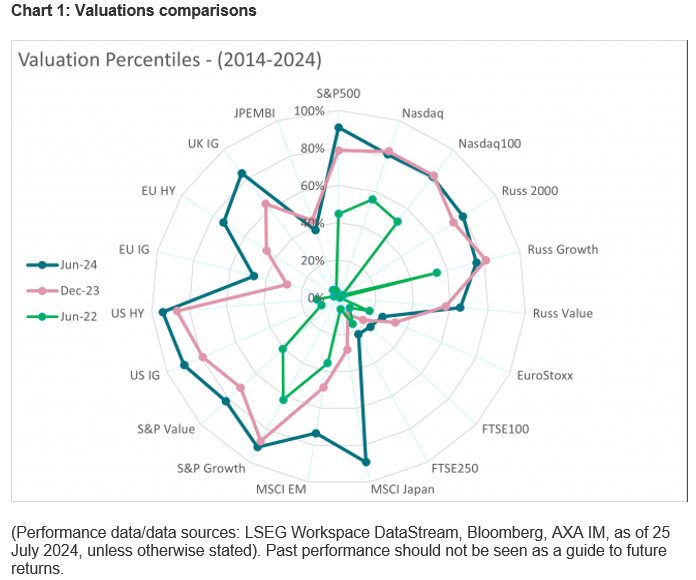Ways to hedge inflation
Rapid increases in inflation – like in 2021 – make it hard to preserve real wealth in the short term, especially as interest rates tend to rise. Yet over the long term, inflation protection can be achieved through exposure to equities, credit assets and gold. In the wake of the recent inflation spike, risk premiums are high in rates and corporates have managed to maintain profit margins. On the assumption that developed market inflation reverts to close to 2%, real returns look to be healthy going forward. The one caveat is that in the US, market indices are distorted by high valuations in the technology sector and other growth stocks. That could mean a period of negative returns but not because of inflation. Over the last quarter of a century, the equal-weighted S&P 500 has delivered the same inflation-adjusted return as the market-cap-weighted index.
The consensus is that inflation in developed economies will remain above central bank targets for some time, with stickiness in service sector prices being the main reason. What happens with wages, especially in services, will determine how inflation will behave going forward and, consequently, how far central banks are able to reduce interest rates. If inflation is to return to close to target, then it is likely that equities again will be the best performing asset class over the long term.
The profit motive helps
It is obvious why equities do better over the long run. When prices go up they feed directly into higher revenues. Companies are, of course, subject to higher costs, but they tend to respond to that to maintain positive margins where they can. Equity valuations reflect that persistence of profits (or promise of profits when it comes to some companies). The downside for equity performance during inflationary episodes is higher interest rates which undercut valuations through a higher discount rate for future (and more uncertain) earnings. However, once rates have peaked and inflation begins to moderate, stocks tend to outperform.
Inflation linked
Bonds that are linked to inflation have been around since the 1980s and have been particularly useful instruments where investors have liabilities that are also linked to inflation, like some pension funds. They function as an inflation hedge when bought at issue and held to maturity. However, during their life they are prone to volatility driven by changes in market interest rates and inflation expectations. That means over different periods, the performance of inflation-linked bonds can be quite different to the performance of inflation itself. Hence, the inferior performance of inflation-linked bonds in recent years, which reflects the balance between the impact of higher rates (negative) relative to inflation accrual (positive). Indeed, shorter-dated inflation-linked bonds did better during the last few years because of their reduced level of interest rate sensitivity. Over the long term the inflation-beating performance is good, delivering an annualised 2.3% inflation-adjusted return in the US market. As such they should be part of an inflation hedging strategy with a long-term horizon.
Building real wealth again
The real value of some assets has been hit by inflation and the market adjustments that were triggered. These have mostly been in the fixed income world where interest rate risk premiums were too low with hindsight. Now rates are higher with positive real rates and inflation premiums that are slightly above central bank target levels. If central banks are successful and long-term inflation expectations have not been unanchored, then real returns across fixed income assets and broader equities should potentially be positive going forward, particularly over what should constitute a longer-term horizon (three to five years).
Just a last point on risk asset valuations. Since the Federal Reserve (Fed) started to increase interest rates in 2022, the valuations of US equity and credit assets have increased. I would suggest this reflects confidence among investors that the Fed would be successful in bringing inflation down and achieving a soft landing. So far, so good. However, considering there is still a record amount of money in money market funds, it is not clear what would happen if cash started to be reallocated into risk assets. Would valuations become even more stretched? Or would a meaningful reallocation only happen in response to a growth shock and following rapid cuts in rates and rapid adjustments in equity and credit valuations? As the spider chart below shows, the US is expensive (price-to-earnings ratios and credit spreads relative to a 10-year history) while the rest of the world is more soberly valued. UK and European equities and euro credit are the cheapest assets in this framework. If investors become worried, the choices seem clear.

100% = Expensive (12-month forward price-earnings ratio at peak of 10-year distribution; credit spread at narrowest of 10-year distribution)
0% = Cheap (12-month forward price-earnings ratio at trough of 10-year distribution; credit spread at widest of 10-year distribution)
5 topics

